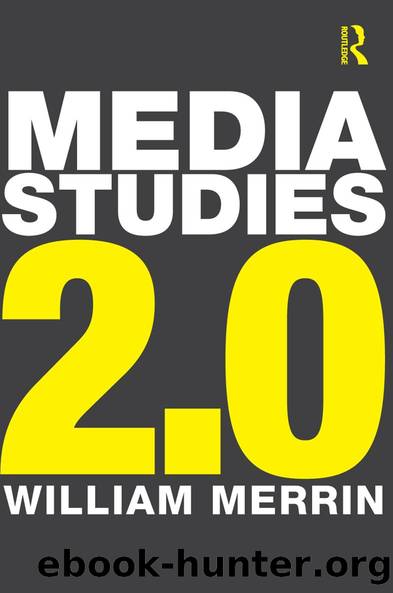Media Studies 2.0 by William Merrin

Author:William Merrin [Merrin, William]
Language: eng
Format: epub
Tags: Social Science, Media Studies
ISBN: 9781136186073
Google: yPMjAwAAQBAJ
Publisher: Routledge
Published: 2014-03-21T05:56:08+00:00
Duck science takes off
Discussing communication studiesâ creation of its own historical narrative, Jefferson Pooley (2008) points out that what was most important was not its accuracy but its existence: âCommunication research, as a field, badly needs the glue of tradition, however invented.â With its vocational taint and âmessy and recently formed institutional trappingsâ, Pooley says, âthe field has from the beginning endured a deficit in legitimacyâ. Ferdinand Tonniesâ 1930 comment as President of the German Sociological Association, questioning the need for a separate communication studies, highlighted the problem: âWhy would we need press research within sociology?â, he asked, â We donât need a chicken or a duck science within biology.â
The question of disciplinary legitimacy is complex, but we can see it involves both internal and external factors. Internal factors include the subjectâs institutional position, its academic activities, its acceptance within the politics of the academy, and its self-identity. External factors include its broader social status and value: its acceptance by government, by employers, by the public and by prospective students and their parents.
It is easy to see that in the post-war period first of all âcommunication studiesâ and then later particular variants of this, usually called âmedia studiesâ or âmedia and communication studiesâ, successfully achieved institutional success, possessing their own departments, chairs and degree-awarding powers, and developing and engaging in academic activities, such as awarding undergraduate and postgraduate degrees, hiring qualified staff, organising conferences, developing peer-reviewed specialist journals, publishing original research and creating professional and disciplinary bodies to oversee the teaching and research interests of the subject area. The contemporary expansion of student interest has ensured media and communication studies is economically important to universities, bringing with it some degree of acceptance within university hierarchies. This leaves the question of self-identity: the subject areaâs framing of its own corpus of accepted theories, knowledge and methods and its agreement upon these.
US âcommunication studiesâ has found this hardest. As a truly interdisciplinary subject it has found it difficult to agree upon a central focus of ideas and approaches. In his influential 1999 paper âCommunication as a Fieldâ, Robert Craig summarised these accumulated problems, arguing that âcommunication studies as an identifiable field of study does not exist yetâ, due to the âlack of consensusâ between different traditions which have had almost no contact with each other. Nevertheless, he argued, the subject had the potential to become a field if dialogue could be achieved through the seven key traditions he identified: the rhetorical, semiotic, phenomenological, cybernetic, social-psychological, socio-cultural and critical perspectives. Though his classification-schema has been reproduced in most communication textbooks, later commentators such as Wolfgang Donsbach (in his 2006 paper âThe Identity of Communication Researchâ, in the Journal of Communication) remain more sceptical, denying even a âcommon objectâ of research among communication scholars and emphasising the continued divisions within this âfieldâ, as well as the problems of its institutional position.
In contrast, media studies has been more successful at achieving an intellectual coherence, developing, by the end of the 20th century, a distinct disciplinary identity.
Download
This site does not store any files on its server. We only index and link to content provided by other sites. Please contact the content providers to delete copyright contents if any and email us, we'll remove relevant links or contents immediately.
Index to the London Magazine by Frank P. Riga Claude A. Prance(197)
Female Impersonation by Carol-Anne Tyler(141)
Creativity and Feature Writing by Ellie Levenson(129)
A Filtered Life by Nicole Taylor Mimi Nichter(123)
Xenolinguistics; Towards a Science of Extraterrestrial Language by Douglas A. Vakoch & Jeffrey Punske(123)
Theories of Journalism in a Digital Age by Steen Steensen Laura Ahva(118)
Critical Communication Pedagogy by Fassett Deanna L.;Warren John T.; & John T. warren(114)
Torture, Intelligence and Sousveillance in the War on Terror by Vian Bakir(112)
Origin Of Ethnography In Japan by Minoru Kawada(112)
Developing Translanguaging Repertoires in Critical Teacher Education by Zhongfeng Tian Nicole King(112)
Computing the News: Data Journalism and the Search for Objectivity by Sylvain Parasie(111)
Transformative Media Pedagogies by Paul Mihailidis Sangita Shresthova Megan Fromm(105)
Peace Journalism in East Africa by Fredrick Ogenga(105)
Matter Transmission by Nicolás Salazar Sutil(99)
A Networked Self and Platforms, Stories, Connections by Zizi Papacharissi(96)
Revisiting Transnational Broadcasting by Nelson Ribeiro Stephanie Seul(96)
Media Studies 2.0 by William Merrin(94)
Media Audiences by Sue Turnbull(94)
The Gentrification of the Internet by Jessa Lingel(94)
